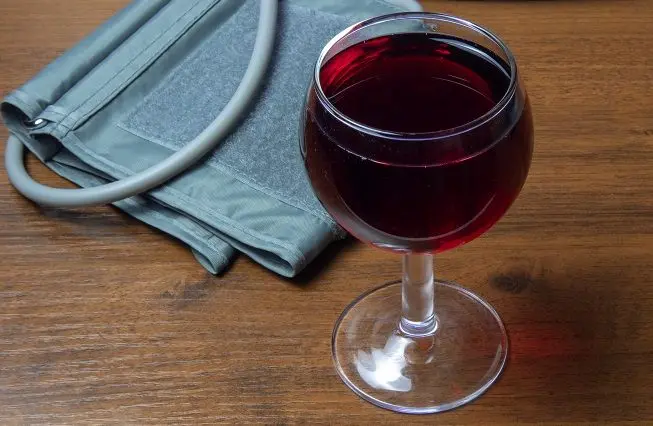Contents
One of the main indicators of health is blood pressure (BP), the parameters of which directly depend on the state of the cardiovascular system. Any pathology manifests itself sooner or later. Even a slight deviation from the norm can lead to serious consequences. Next, we will understand how different wines (red, white, dry, fortified) change blood pressure.
Dry red wine
The question of the effect of wine on blood pressure has always been of interest to doctors and patients. Many scientists are of the opinion that regular intake of small doses of dry red wine (50-100 ml per day) is good for health. But the drink should be natural, without coloring additives and preservatives.
Weak (from 9 to 11,5%) ruby-colored wine, with a pleasant tart taste and delicate aroma, is obtained from red and black grapes. Whole berries are used: with peel and seeds, which release many useful substances into the juice.
In addition to vitamins B and A, C, E, PP, red wine contains trace elements important for the body: iodine, magnesium, phosphorus, potassium and iron. The composition of the drink contains complex organic antioxidant substances that have the properties to bind free radicals, positively influence the state of the cardiovascular system and help normalize blood pressure.
Polyphenols (flavonoids) found in red wine:
- Resveratrol (polyalexin of plant origin). This substance improves the condition of the endothelium – the inner layer lining the blood vessels, and stimulates the production of nitric oxide (NO), which is necessary for increased blood circulation. Resveratrol slows down the formation of cholesterol deposits on the walls of blood vessels and prevents their narrowing, which contributes to the normalization of pressure.
- Tannins are tannins that strengthen the walls of blood vessels and increase their elasticity, protecting them from pathologies that occur during atherosclerosis.
- Procyanides (anthocyanins), which give red color to wine, are very useful for blood vessels – glycosides that are found in red and black grape varieties. They also reduce the risk of heart disease.
Vintage red dry wine lowers blood pressure. The effect is much longer than with the use of other types of alcohol, when blood pressure rises again after half an hour. According to doctors, the fruit acids contained in natural red wine relieve spasms of blood vessels after the effect of alcohol ends.
Judging by the results of medical studies, a decrease in blood pressure after drinking a drink occurs only in cases where it was initially increased.
The well-known “French paradox” testifies in favor of the use of dry vintage wines in small doses for the treatment and prevention of many diseases. The French are true fans of red wines: not a single meal is complete without a glass of this drink. But the statistics of cardiovascular diseases and pathologies of the digestive system is the lowest in the world. And you can’t call French cuisine dietary. Most likely, the healing properties of wine help gourmets to stay healthy by eating food rich in cholesterol.
The use of grape juice from the same grape varieties does not give a therapeutic result, as well as the intake of dietary supplements containing polyphenols or glycosides. All these bioactive substances act only in the composition of wine.
But you need to remember that the “medical” dose of dry red wine is 50-100 ml per day, which is equal to 2-3 glasses per week, at dinner. Exceeding the norm can give the exact opposite effect and provoke an exacerbation of chronic or the emergence of new diseases.
For those who do not like alcohol, it is recommended to dilute the wine with table mineral water in a ratio of 1:2. At the same time, all useful substances are preserved in the drink.

Red table wine
Sweet, ethanol-fortified table wine raises blood pressure, as does all strong alcohol, including a variety of aperitifs and liqueurs. Once in the blood, ethanol dilates blood vessels, but not for long. The acceleration of the heart rate increases the volume of blood passing through the vessels per unit time, and increases the pressure on the walls.
It is better not to use red table wine with high blood pressure: you can only aggravate the condition and cause a hypertensive crisis.
Features of table and dry white wines
White grape wines, unlike red ones, are made from any grape: both dark and light. The juice of almost all varieties, with rare exceptions, has a golden color if it does not come into contact with the colored peel and grains. Winemakers try to separate the juice from the seeds and berry skins as quickly as possible. Therefore, the composition of white wine does not contain many of the components that are present in red varieties.
Dry white wine contains many useful substances, including antioxidants, which are better absorbed by tissue cells, since their molecules are smaller than those of red varieties. No white wines have the ability to lower blood pressure: neither dry nor sweet table wines.
But such wines at reduced pressure gently increase it and improve blood circulation. Red table wine gives the same effect. It is very important to observe a safe rate, it should not exceed 100 ml per day.

Who should not drink wine at all
A person does not always know exactly what diseases he already has in a latent (latent) form. Therefore, it is recommended to attend preventive examinations by a cardiologist so as not to miss the onset of a serious disease of the heart and blood vessels.
The use of alcoholic beverages is undesirable for those diagnosed with the following diseases:
- gastric or duodenal ulcer, gastritis, pancreatitis;
- hypertension;
- migraine (frequent attacks of headache);
- allergy in any form: with skin manifestations, mucosal edema and asthmatic syndrome;
- bronchial asthma;
- alcohol dependence and mental disorders (depressive states).
You can not combine taking medications for cardiovascular diseases with the use of alcohol. Ethanol enhances the effect of drugs, which can lead to unpredictable consequences.
It is urgent to call an ambulance team if the following symptoms appear after drinking alcohol:
- BP changed dramatically, increased above 150/110 or fell below 90/50 mm Hg. pillar;
- disorder of consciousness: excessive motor activity or fainting;
- vomiting that cannot be stopped with home remedies;
- obvious autonomic disorders (palpitations, cold extremities, blanching or redness of the skin);
partial or complete paralysis.
So that the holiday is not overshadowed by troubles, all alcohol must be of high quality, counterfeit products have no place on the table.









